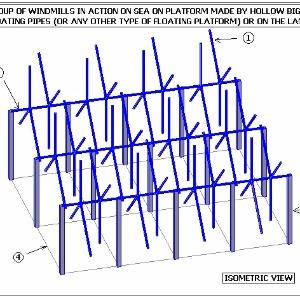
Energy generation by using compact group of floating windmills on sea. by Ocean energy group
 Michal Monit Sep 6, 2017 10:43 | Dear Mahesh, |
 Mahesh Khati Sep 7, 2017 04:34 | Proposal contributor 1) I will try to add pictures of miniature working model & other drawing in the proposal. ( I was unable to post all that here) 2) As there are parallel continuous shafts supported at multiple points problem of buckling will not create a problem in this model but will create compactness due to multiple attachment points. 3) Sea can fully satisfy our need for energy if properly tap. |
 Betsy Agar Sep 10, 2017 01:07 | Hi Mahesh, this is an interesting introduction to a difficult problem. Can you tell me how the "raft" of turbines is anchored so that it orients appropriately to maximize wind capture? |
 Mahesh Khati Sep 12, 2017 07:50 | Proposal contributor Important question. This problem has 3 solutions 1)Fixed raft:- If direction of air flow is generally fixed for example land ward side or sea ward side then fixed raft can be used. In this case this floating raft is fixed & will not change its direction and properly anchor to sea bottom by chain. 2)Raft optimizing energy generation by mechanically orienting raft :- In this case turbine are attached at the end points of big floating raft run automatically & shut down and orient raft mechanically in the direction of wind. This turbine will use partial small power of huge energy generated by compact wind turbines mounted on raft. 3)Automatic orientation of raft:- This can be done like kite orient in sky in the direction of wind. This whole raft is tied to the bottom of sea at one hing point which is free to rotate by multiple chains. Whole raft will automatically orient it self in the direction of wind due to wind pressure. |